Missing Mendes Cohen
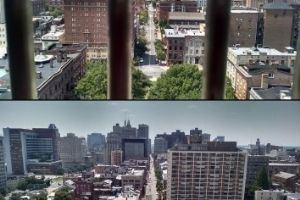
A blog post by Education Director Ilene Dackman-Alon. To read more posts by Ilene click HERE.
I love walking into the Feldman Gallery and looking at so many movie posters from the past . I love the way that Joanna and our interns have delved into research to seek out the images of the movie theaters that actually showed the movies during the 1930-1960’s. I have enjoyed listening to our visitors reminisce of the past but I do have to admit….I am missing the Amazing Mendes Cohen! I miss not seeing Mendes’ face in the Feldman Gallery, both donning a turban and also posing as a young man in the early 19th century. I miss not hearing the piano music of Charles -Valentin Alkan, as you enter the gallery; one of the first Jewish composers to incorporate Jewish melodies to his music. I miss the puzzle pieces and watching groups of students working together to put puzzle pieces in place. I see Flat Mendes every day- but I still miss the Amazing Mendes Cohen in my life at the JMM.
This past weekend- my hubby and I decided to play tourist in Baltimore in the hope that I could get “my fix” of Mendes Cohen. On Sunday we started our day at the Farmer’s Market underneath the Jones Falls Expressway. After buying two coffees, pastry, and two kinds of string beans; we headed north to Mount Vernon. In particular, I wanted to climb the Washington Monument which was rededicated on July 4, 2015; 200 years after the initial cornerstone was laid on July 4, 1815. I wanted to see the building where Mendes and the famous Cohen brothers were instrumental in the state – funded lottery business that helped to raise the money to build the first monument dedicated to the first President of the United States, George Washington. I wanted to see some sort of mention of Mendes Cohen at the monument.
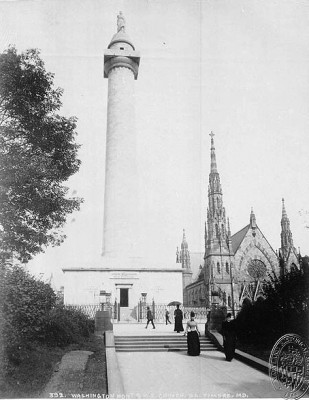
Robert Mills is credited with the design of the structure of the Washington Monument. I understood that the citizens of Baltimore were particularly proud to erect this monument to Washington in light of their recent role in securing American liberty during the Battle of Baltimore, a turning point in the War of 1812. Baltimoreans were also proud that the monument was built of local white marble, from quarries north of the city.
I was excited to begin my 160 foot climb to the top. I thought it was interesting to see how the bricks were laid on their sides in a circular ring as we hiked up the steps.
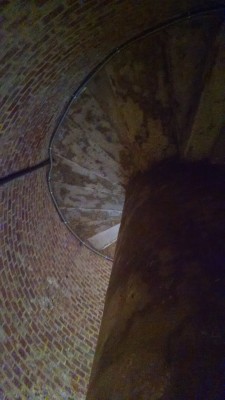
I also thought it was interesting to see how narrow the space was and I understood that the staff at the Mount Vernon Place Conservancy only allows five people to climb the monument at any given time during tours.
As we continued our climb up the narrow steps, I was happy to see a marker dated 1818 noting that we had climbed 106 feet.
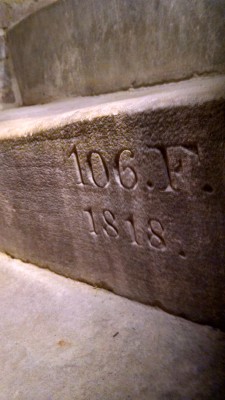
I also noticed some graffiti where someone had written “1908” in black on the walls. By 1829, the main column of the monument was completed, and the statue of Washington, sculpted by the Italian artist Henrico Causici, was raised to the top. As we were getting closer to the top, I was excited to see the view- and I wondered if Mendes ever climbed the steps to the top and saw the spectacular view of Mount Vernon Place.
When you get to the top of the monument, you do get a chance to see Baltimore from all directions north, east, west and south. However, you must stay inside and behind the glass to take your pictures….. a bit disappointing. At the top, you begin to understand how the Washington Monument quickly became an important symbol of the city and state of Maryland. President John Quincy Adams, who assisted in composing the text of the bronze inscriptions on the monument’s base outlining the key events in Washington’s life, dubbed Baltimore “The Monumental City.”
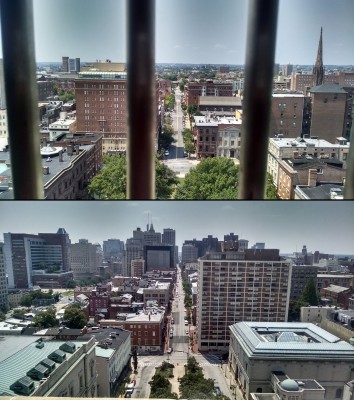
As we climbed down, I realized how lucky we were to have had the opportunity to climb to the top. I am certain the citizens living in Baltimore in the early 19th century were in awe of this impressive structure built and dedicated to the nation’s first president. It was fun to imagine Mendes Cohen wandering the grounds where the monument was built in the early 19th century. The structure is a wonderful testament to the builders of Baltimore and a beautiful place for citizens to gather and enjoy all that Baltimore has to offer.
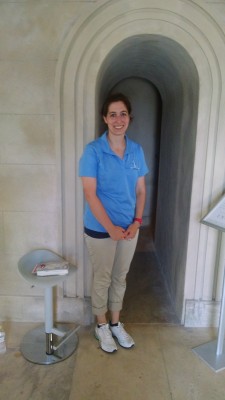
I want to thank JMM Museum Educator, Kelly Suredam Potter, who also works at the Mount Vernon Place Conservancy for telling me about the opportunity to climb the monument. It was a lot of fun to climb this iconic landmark as well as try to appease my longing to connect with the Amazing Colonel Mendes I. Cohen. Long Live Mendes!
